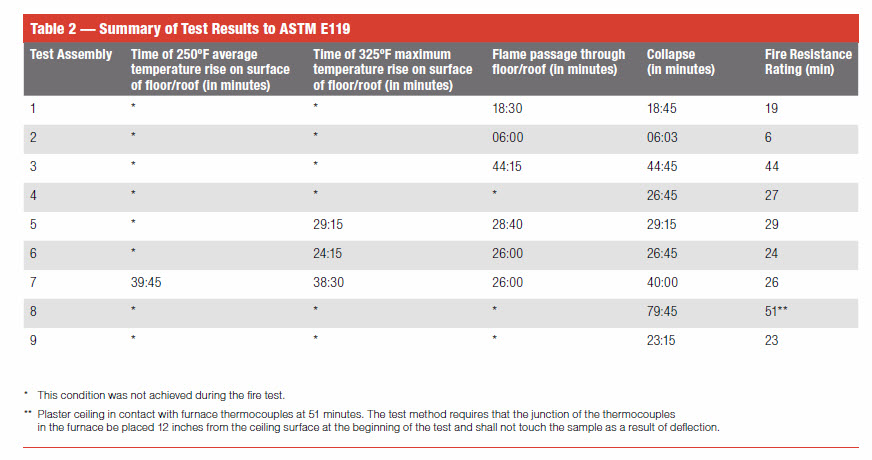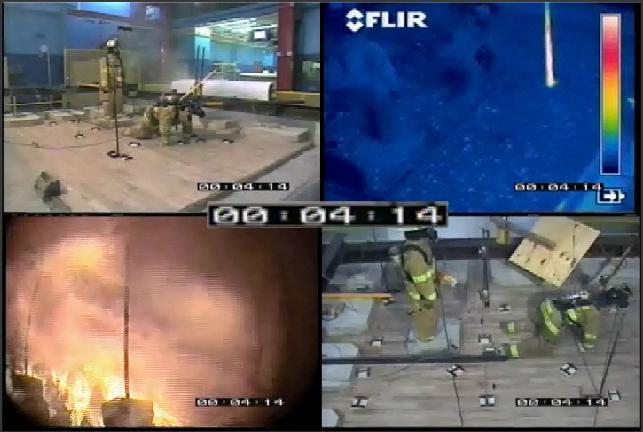Underwriters Laboratories Structural Stability of Engineered Lumber in Fire Conditions
By Christopher J. Naum, SFPE on Jan 07, 2011 with Comments 0
Structural Stability of Engineered Lumber in Fire Conditions
Under a U.S. Department of Homeland Security (DHS) Assistance to Firefighter Grant, Underwriters Laboratories in collaboration with the Chicago Fire Department, Michigan State University, and the International Association of Fire Chiefs completed a fire research study to enhance understanding of hazards to firefighters posed by use of light-weight construction of wood trusses and engineered lumber in roof and floor designs that are increasingly replacing conventional solid joist construction in residential structures. The project investigated and compared the fire performance of conventional solid joist lumber and light-weight lumber as used in floor and roof construction and correlated these to fully instrumented fire tests. The fire tests in combination with fire performance data on lumber allows fire professionals to better interpret fire hazards and assess risk for life safety of building occupants and firefighters.
For more information about this project:
- Grant Report(NC9140-20090512-Report-Independent.pdf),
- Report on additional fire tests (NC10412-20090130-Report-Independent.pdf), and
- Report on the modeling phase (DHS_Report_Modeling_Floors_1208_final.pdf).
Structural Stability of Engineered Lumber in Fire Conditions – Online Training
This online firefighter training course is the result of a research partnership among UL, the Chicago Fire Department, IAFC, and Michigan State University, funded in part by the U.S. Department of Homeland Security. This self-guided course, which focuses on the structural stability of engineered lumber under fire conditions, is targeted toward the 1.1 million fire service personnel in the United States and Canada. The knowledge developed and shared in this course is critically important to firefighter and civilian safety.
Publications
- Battling the Hidden Danger – FireRescue Magazine: February 2010 – pp 72
- Structural Collapse: The Hidden Dangers of Residential Fires – Fire Engineering University Continuing Education Course
- Structural Stability of Engineered Lumber in Fire Conditions – The Fire & Security Authority: 2009 Issue 3 – pp 1
- Working to Live: Making Fire Fighting Safer – International Fire Fighter: January/February 2009 – pp 20
Background on the UL research project
For more than 35 years, the fire service community has repeatedly expressed concern regarding the structural performance of wood “I” beams and wood trusses commonly known as lightweight wood construction during a fire. In October 1992, the National Fire Protection Research Foundation published a report titled, “National Engineered Lightweight Construction Fire Research Project — Technical Report: Literature Search & Technical Analysis.” The report cited 60 articles published between 1970 and 1990 related to the fire performance of lightweight wood construction. The report identified the need for fire performance data and training focusing upon the fire performance of lightweight wood construction. These needs remain today and have been amplified by incident reports collected by the National Fire Fighter Near-Miss Reporting System and National Institute for Occupational Health(NIOSH) Fire Fighter Fatality Investigationand Prevention Program.
Because of concern for fire fighter safety and misinformation out in the field, UL approached the Federal Emergency Management Agency to offer assistance. Because no standardized tests had been conducted to compare traditional to modern assemblies, UL considered it important to develop a comprehensive test plan to research the fire performance of assemblies representative of typical residential construction, the different materials within floor assemblies and various other factors. In addition, the result from such research was to be developed into a fire fighter training program. UL test plan The test plan called for nine fire tests: seven floor-ceiling assemblies and two roof-ceiling assemblies.
A goal of the project was to develop comparable fire performance data among assemblies. All assemblies were intended to represent typical residential construction, with some assemblies representing legacy construction methods and materials and others representing modern methods andmaterials including lighter weight wood structural members. Two of the assemblies did not include a ceiling; six of the assemblies included a ceiling consisting of ½ inch regular gypsum board; and one assembly included a ¾ inch plaster ceiling. Standard ASTM E119, Fire Tests of Building and Construction Materials, describes a fire test method that establishes benchmark fire resistance performance between different typesof building assemblies. For floor-ceiling and roof-ceiling assemblies exposed to a standardized fire, the standard requires that a minimum 180 square foot sample prohibit the passage of flame and limit the temperature rise at specific locations while supporting a load. The standardized fire represents a fully developed fire within a residential or commercial structure with temperatures reaching 1,000ºF at five minutes and 1,700ºF at 60 minutes.
The nine fire tests conducted by UL complied with the requirements of ASTM E119, but the applied structural load was nontraditional. Typically, a uniform loadis applied on a floor or roof to fully stress supporting structural members. This load is generally higher than the minimum design load of 40 pounds per square foot (psf), as specified by the building code for residential construction. For the UL fire tests, the sample load was intended to represent typical conditions during a fire. A load of 40 psf was placed along two of the four edges of the floor-ceiling assemblies to represent loads on the perimeter of a room. On each sample, two 300-pound mannequins simulating fire service personnel were placed near the center of the sample. For the two samples that represented roof-ceiling assemblies, the two mannequins were the only live load applied on the test sample. Table 1 summarizes the construction details of each test sample.
Test results The results of the ASTM E119 fire tests are expressed in terms of hours such as ½ hour-, 1 hour- or 2 hour-rated assemblies. Because all fires are different with respect to room size, combustible content and ventilation, these time ratings are not intended to convey the actual time a specific structure will withstand a fire. Instead, the ASTM E119 test method provides a benchmark that enables a comparison of fire performance between test samples. For unrestrained floor-ceiling assemblies and unrestrained roof-ceiling assemblies such as the tested samples, ASTM E119 includes the following conditions of acceptance:
The samples
- hall support the applied load without developing conditions that would result in flaming of cotton waste place on the floor or roof surface
- Any temperature measured on the surface of the floor or roof shall not increase more than 325ºF and the average temperature measured on the surface of the floor or roof shall not increase more than 250ºF
The results of the nine fire tests in terms ofthe ASTM E119 conditions of acceptance are summarized in Table 2. The objective of this research project was to develop fire endurance data on assemblies to compare the fire performance of legacy construction (dimensional sawn cut lumber, solid sub- and finish flooring) to that of modern protected and unprotected lightweight construction (engineering structural elements, oriented strand board subfloor and carpeted finish flooring). One insightful comparison is that of time to collapse:
The unprotected
- legacy construction (assembly 1) collapsed at approximately 19 minutes as compared to six minutes for the unprotected lightweightconstruction (assembly 2)
- Adding a non-fire rated, generic ½ inch thick gypsum board increased the time to collapse for legacy construction (assembly 3) to 44 minutes, an improvement of 25 minutes
- For modern construction (assembly 4), the installation of ½ inch gypsumwallboard increased the time to collapse to approximately 27 minutes, an improvement of 21 minutes
Of particular interest is the time to collapse of very familiar traditional construction, dimensional sawn cut lumber protected by a metal lath / plaster ceiling (assembly 8). This assembly demonstrated the longest time — nearly 80 minutes — to structural collapse.
Computational modeling Computational modeling of the fire response of building materials, components and systems is gaining ground due to advances in analysis techniques and computing technology. As part of this project, UL studied the challenges of using computational modeling tools to simulate the fire performance of wood-based components. Using the commercial finite element (FE) software ANSYS©, sequentially coupled thermal and mechanical analyses were conducted for two unprotected floor assemblies: a conventional wood floor (Assembly 1) and an engineered wood floor (Assembly 2). The main challenge in modeling wood floors as opposed to other common building materials such as steel, concrete and masonry is that wood burns and chars. As such, any model predicting performance of wood-based structural systems must account for this behavior.
The FE models of the floor assemblies were built based on detailed construction drawings and included all relevant boundary and loading conditions of the floor furnace test. However, a very critical input to the FE models was the thermal and mechanical properties for the constituent materials. In a fire environment, construction elements are exposed to a very wide temperature range that reaches high temperatures. Over this wide
range, wood degrades and decomposes significantly, changing material properties such as thermal conductivity, modulus of elasticity, etc. So it is important to have material property data for the different wood components over the entire temperature range of interest. As such, these properties will also include wood in its charred state. The input material properties for both the thermal and mechanical analyses were measured from wood samples of the two floor assemblies by Michigan State University under the direction of Dr. V. Kodur.
Thermal results for the model were computed using a transient analysis that included radiation, convection and conduction modes of heat transfer. For structural results, a nonlinear, quasi-static elastic analysis was performed at select points in time. For the thermal model, comparison with thermocouple measurements pointed to the importance of adding internal heat generation elements to simulate the actual burning of wood and accurate measure of temperature dependent material properties of the wood and the char. Though the model did not accurately predict the final deflection magnitudes, the structural model did predict that floor assembly 2 would lose structural stiffness at a much faster rate than floor assembly 1. By designing and conducting tests similar to those described in this article and building test databases, UL is continuing research on improving the predictive capabilities of computer models for wood burning building components and systems.
Getting the word out to the fire service To get the word out to the fire service, UL made numerous presentations at symposia sponsored by fire house and fire protection engineering trade media; the 2008 Chicago Fire Department’s Strategy & Tactics Conference and Expo; UL’s 2008 Global Fire Service Leadership Conference; the Georgia Fire Chiefs Association meeting; and the Colorado Fire Marshals and ICC Code training symposia, 2009 NFPA Conference & Expo, FIRE 2009 Flammability & Combustibility in Building Materials Conference, and the 2009 IAFC Fire Rescue International Conference. The January/February 2009 issue of the International Fire Fighter distributed to more than 370,000 U.S. and Canadian fire fighters highlighted the research. UL’s research was covered by WISN-TV in Milwaukee.A free web-based training program for the fire service providing a summary of the tests and lessons learned is available on UL’s Web site at www.ul.com/ltwtconstruction
-
Report Publication Summary: http://www.ul.com/global/documents/corporate/aboutul/publications/newsletters/fire/fsa_issue_3_2009.pdf
Filed Under: Anatomy of Buildings • Engineered Systems & Materials • Research • Research Hub


























